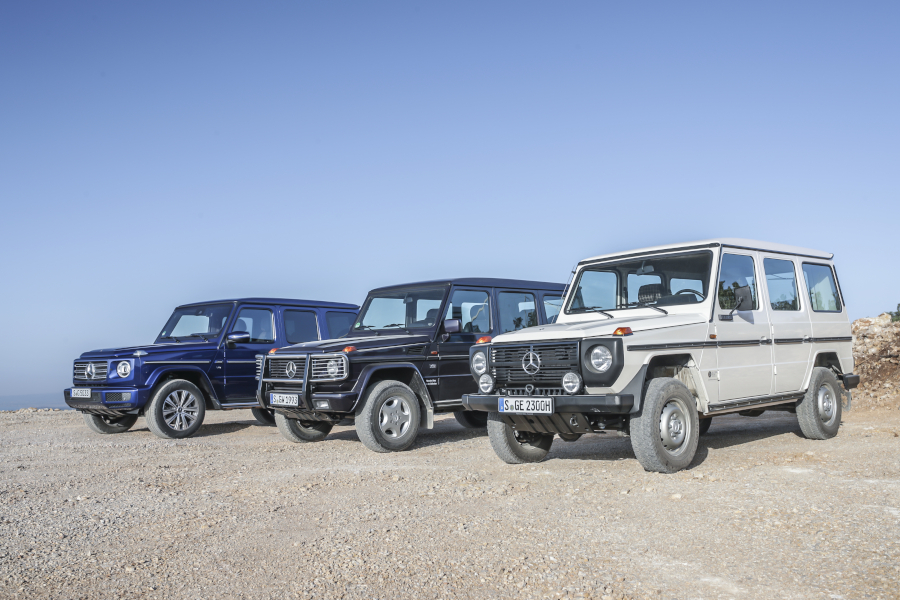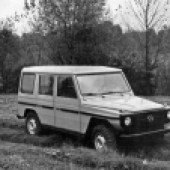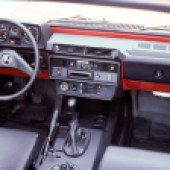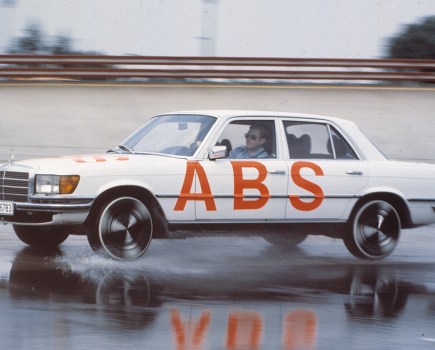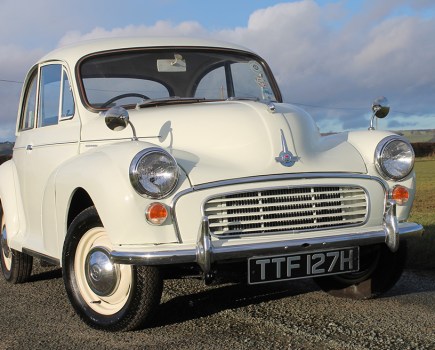Only one car combines Land Rover off-road ability with Land Cruiser solidity and Range Rover prestige: the Mercedes G-Class
Words: Paul Wager Images: Mercedes
The G-Wagen was originally developed as a military vehicle and popular rumour will tell you that it was at the suggestion of the Shah of Iran, although this is something Mercedes’ own history of the vehicle doesn’t mention.
Instead, the official history begins in 1969 with discussions between Daimler-Benz and Steyr-Daimler-Puch about possible cooperation on off-road vehicles. It’s easy to forget that both marques were already well respected in the field: Puch for its Haflinger and Pinzgauer and Mercedes having produced the Unimog since 1948.
The result of the discussions was an agreement in 1971 to produce a less extreme, less agricultural off-road vehicle which could also be used on the road, something which suggests the Germans had already realised the significance of the newly-launched Range Rover.
The first mock-up was created in 1973, the G-Wagen’s functional lines destined to become something of a signature even after being tidied up by legendary Mercedes stylist Bruno Sacco.
Prototypes were running by 1974 and was very much a traditional off-road system with a separate chassis and manually selected four-wheel drive and differential locks. Like the Range Rover, the G-Class used solid axles with coil springs and its shallow front and rear overhangs allowed useful approach and departure angles.
Production began in 1979 at Puch’s Austrian facility near Graz, with components delivered from all over the Mercedes operation and the project overseen by a joint-venture company, Geländefahrzeug Gesellschaft.

Pre-production cars pictured in 1975
That first G-Wagen went under the Mercedes model code W460 and included just four engine options: the petrol 230G and 230GE and the diesel 240GD and 300GD. In contrast, the model range was vast, thanks to a choice of two different wheelbases (2400mm and 2850mm), offered in hard and soft-top body styles and as estate/station wagon or panel van.
Mercedes’ press material boasts of a continuous development programme for the G-Class and a facelift in 1981 recognised the civilian appeal of the vehicle when air conditioning, automatic transmission and an expanded choice of paint colours were added to the options list alongside headlamp grilles, a power take-off and a hardtop for the open model. In 1982, the 230G was replaced by the fuel-injected 230GE, with a five-speed manual added the following year.
By 1986, some 50,000 G-Wagens had left the Graz facility and in 1987 the vehicle gained optional electric windows while the 240GD was replaced by the 250GD.
The G-Wagen would have to wait for any major updates until the W463 model unveiled at the 1989 Frankfurt show was launched in April 1990. Essentially a major facelift of the original, the new model gained permanent four-wheel drive, a more car-like interior and optional ABS. With three different body styles, it was initially offered as the 230GE 300GE, 250GD and 300GD.
Recognising its urban appeal, Mercedes offered cruise control from 1992, plus the signature stainless steel spare wheel cover and side steps, the popularity of the G-Class illustrated neatly by the 100,000th example leaving the line this year.

A glimpse into the G-Wagen’s future came in 1993 when the limited edition 500GE was announced at the Geneva show, featuring the 5-litre M117 V8 engine shoehorned into the G-Wagen chassis by none other than AMG. Retaining the regular G-Class’s four-wheel drive system, the 500GE had to make do without the front differential lock but with 240bhp took just 60mph to reach 62mph. With suitably lavish interior and offered only in five-door long-wheelbase form, the AMG hot rod was twice the price of the G320 and was offered for only a single year before the V8 was bored and stroked to 5.9 litres and 300bhp, by which time the model names had been reversed to follow the rest of the Mercedes range.
In 1994, the regular G-Class models gained driver’s airbag, remote locking and upgraded ABS, while the G300 was replaced by the automatic-only G320 rated at 210bhp. In 1996, the 177bhp G300 Turbodiesel replaced the 350GD, using a four-valve, twin-cam intercooled engine and again offered only with the five-speed automatic.
In 1997, the Cabriolet was revised to gain electric roof operation and from November, the G320’s straight-six engine was replaced by the new M112 V6 engine rated at 215bhp.
The unexpected popularity of the go-faster G-Wagen ensured it became a full production model in May 1998, powered by the M113 V8 rated at 296bhp and badged as G500, although if that wasn’t good enough AMG could still go one better with the 5.5-litre, 354bhp G55 AMG, unveiled in July 1999 to mark the 20th anniversary of the G-Class.
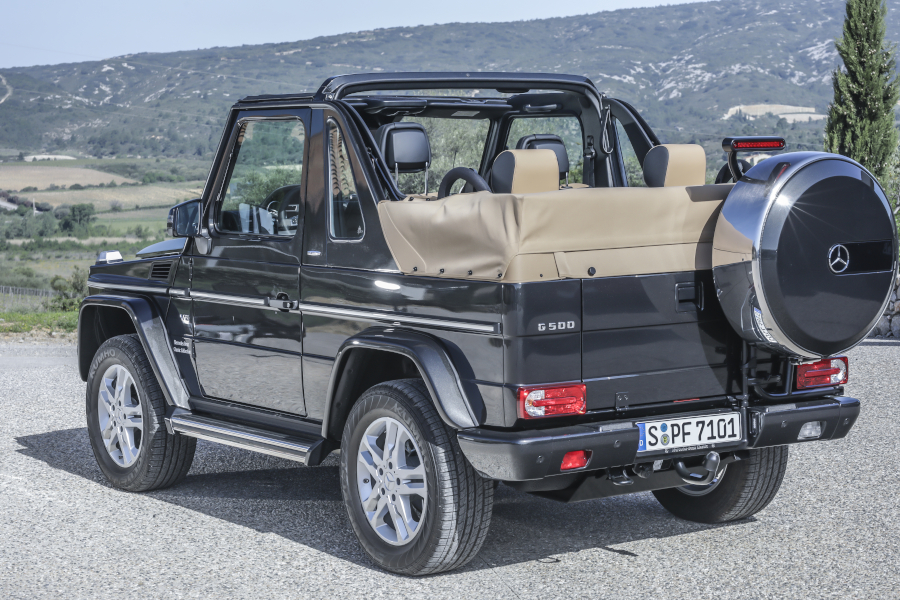
The G500 became a full production mode in May 1998
In December 2000, the G-Class received a major facelift, gaining a modernised interior and tech available in other Mercedes models including the COMAND system. Clear indicators and two-colour rear lights distinguished the facelift cars. In January 2001, the S-Class’s 4-litre V8 diesel was offered in the G400CDI, complemented by the five-cylinder 270CDI. An electronic traction control system was offered later in the year which made the G-Wagen one of the most capable off-roaders on the market.
The year 2001 would also prove to be significant for the G-Class in another way when the model was offered in the US for the first time, a market which just seven years later would account for 20 per cent of sales.
For 2004, AMG turned up the wick again with the revised G55 which strapped a supercharger to the M113 V8 for a 476bhp / 700Nm result, raised to a nice round 500bhp in 2007.
By 2005, the G-Wagen had been with us for 26 years and 185,000 had been produced, but questions were being asked over its future in a climate of ever more stringent emissions and safety legislation. Fortunately, the decision was taken to keep the model in the line-up and the vehicle received an intensive programme of future-proofing updates.
In 2008, bi-xenon lights were fitted, while the G320CDI replaced the previous two diesel models and in 2008 the G500 was updated to a more modern four-valve M273 V8 rated at 388bhp, the new model identified by its three-slat grille.
For the 30th anniversary in 2009, two EDITION30 special editions were produced, based on the G500 and the G280CDI and in 2012, AMG picked up on the trend for ever more outrageous performance cars by creating the 5.5-litre twin-turbo V8 G63 AMG boasting 544bhp, plus the 612bhp V12-powered G65 AMG offering over 1000Nm of torque.
As if a V12-ngined G-Wagen wasn’t outrageous enough, the following year saw the G63 AMG 6×6 debut, boasting Unimog-style portal axles and no less than five differential locks. It had its origins in an Austrian army military vehicle but entered limited production from 2014 with the 5.5-litre twin-turbo V8 engine.
A slightly less outrageous four-wheeled G 500 4×4² was offered in 2015 with the normally aspirated V8.
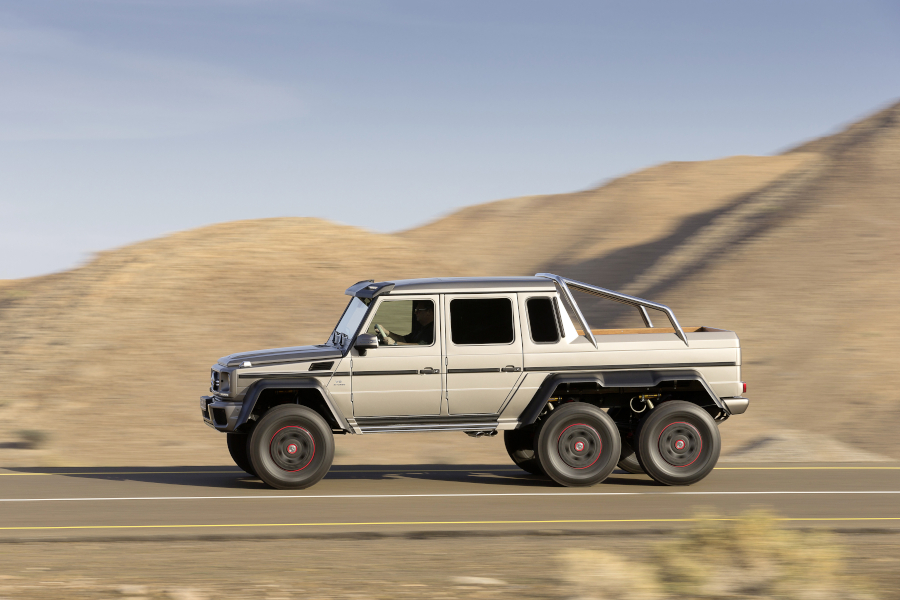
The G63 AMG 6×6 was a novelty on the civilian market but a less extreme six-wheeler was used by the Australian army
Despite the age of the underlying design, the appeal of the G-Class remained as strong as ever, with the Graz factory producing 20,000 examples in 2016 – the highest ever annual production figure.
No surprise then that the Daimler-Benz board decided it was worthwhile investing in an all-new model, which duly arrived in 2018, when it was unveiled at the Detroit show – the location telling you all you needed to know about the importance of the US market.
Described as a ground-up redesign, the new model retained the W463 model code but saw the greatest changes to the G-Wagen’s structure since the 1970s. The bodyshell’s rigidity was improved by 55 per cent while also losing 170kg in weight thanks to aluminium wings, bonnet and doors plus the use of high-strength steel in critical areas alongside bonded glass.
The separate chassis remained, but the rigid front axle was replaced by an independent double-wishbone layout developed by AMG and mounted directly to the chassis without a subframe in order to allow the greatest possible wheel movement when off road. The rear end retained the rigid axle but added four trailing arms on each side plus a Panhard rod for lateral location. Meanwhile, rack-and-pinion steering offered a new degree of precision while also allowing modern safety features like automatic lane assistance.
Today’s G-Class model line-up reads like a smack in the face to modern green thinking, spanning as it does the G500, G450d and AMG G63. Much like our own Land Rover Defender though, the G-Wagen can’t escape the march of progress, especially the transition to electric drivetrains. Which is why Mercedes has indicated that production will end this year, with the new ‘EQG’ EV version already teased and expected to launch imminently.
Mercedes G-Class facts
• The first prototypes were constructed not in the usual modelling clay but made from wood.
• The fully synchronised transfer box was one of the few mechanical components not to be supplied by Mercedes and was developed by Steyr-Daimler-Puch.
• Despite all the online rumours that the G-Wagen was invented by the Shah for the Iranian army, Mercedes’ own press material insists it was never designed as a military vehicle.
• G-Class models sold in Austria and Switzerland were badged as Puch rather than Mercedes.
• From July 1986 a special version of the 250GD was produced which was classified as being safe to use underground in mines.
• Pope John Paul II used a G-Wagen Popemobile, initially a 230G then the injected 230GE. That clearly wasn’t enough for the petrolhead Pontiff who upgraded to the G500 in 2007.
• The Popemobiles featured a rear floor raised by 400mm and a special climate control system to stop the Pope being fogged up inside his protective Plexiglass dome.
• The relatively narrow 1700mm width of the G-Class was tailored to Alpine tracks.
• In 1983 Paris-Dakar winners Jackie Ickx and co-driver Claude Brasseur made history when their 280GE completed a stage faster than a motorcycle.
• The original W460 remained in production for military buyers after the introduction of the new model in 1990 and was given the production code W461.
• Export models produced as CKD kits were given the production code W462.
• In 2008 the Australian army ordered 800 of the 6×6 variant.
• The G-Wagens used by the German armed forces are known by the name ‘Wolf’ – not to be confused with the uprated Land Rovers used by the British MoD.
• The Peugeot P4 was based on the G-Wagen but used Peugeot engines and transmissions.
• In 2022 the military W461 was replaced by a W464, based on the revised 2018 G-Wagen but retaining the rigid axle of the original as well as 24-volt electrics and heavy-duty chassis.

